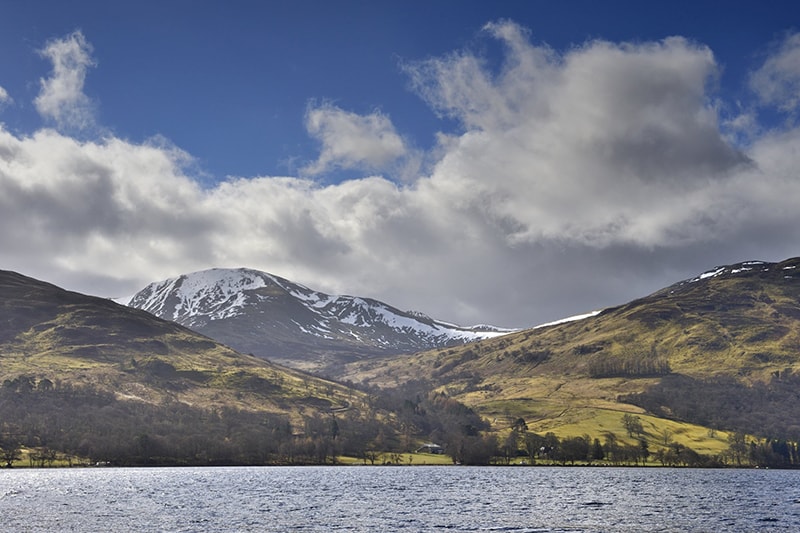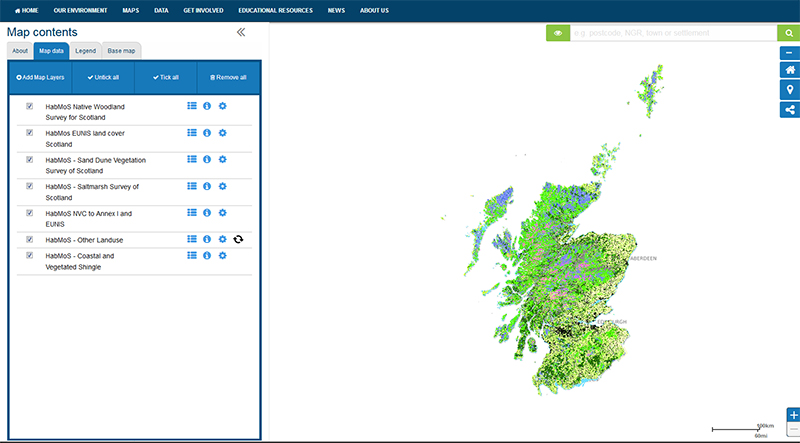The 2020 Challenge for Scotland’s biodiversity made a commitment to produce a “comprehensive map of Scotland’s main habitats”.
Ben Vorlich and Loch Earn near Lochearnhead in the Loch Lomond and The Trossachs National Park - © Lorne Gill, NatureScot.
What is the Habitat Map of Scotland?
The Habitat Map of Scotland (HabMoS) is the national repository for habitat and land use data. The map adopts internationally recognised data and habitat classification standards.
HabMoS is a composite map. It contains data, from many different sources, which have all been re-classified into EUNIS, the European Nature Information System. If you want to know more about how data were re-classified the correspondence between NVC and EUNIS and Annex I is explained in NatureScot's commissioned report 766: Manual of terrestrial EUNIS habitats in Scotland.
Why do we need a Habitat Map of Scotland?
We need this map because although we have a lot of existing data it is spread over many locations, in many different classifications. In order to allow policy and management decisions to be made with the greatest ease we need to have a resource that pulls everything into one place.
The unique feature of the map is that it brings together in one place and in one classification system all available habitat and land use data. It is this ability to view a range of data from different sources which makes it a powerful tool for analysis, planning and policy development at national and local levels.
HabMoS sets a new standard for collaboration within Scotland. Organisations spanning the government; voluntary and private sectors have supplied data in an informal, willing and collaborative partnership.
The map uses European Nature Information System (EUNIS) and Habitats Directive Annex I habitat classifications. At the present time almost 800 site surveys and all existing national habitat surveys have been brought into use. For example, the woodland component is converted from surveys undertaken by Forestry and Land Scotland. The Identity of original surveys is retained, so it is always clear where data has come from.
Gallanach, Isle of Coll - © Lorne Gill, NatureScot.
Explore the data
The Habitat Map of Scotland (HabMoS) data is available to view on this website. There are eight HabMoS layers available to view in Scotland's environment map - these map layers can be viewed collectively or individually.
View the HabMoS map layers collectively:
View the HabMoS map layers individually:
More information on each of the HabMoS layers is available below.
HabMoS EUNIS Land Cover Scotland
The HabMoS EUNIS Land cover Scotland (HabMoS ELCS) is a broad scale EUNIS map that provides a seamless coverage. As HabMoS develops it will replace the less detailed information in ELCS. This data is also referenced in the Ecosystem Health Indicators - Condition Indicator for landcover.
View the HabMoS EUNIS Land Cover Scotland map layer.
HabMoS Coastal and Vegetated Shingle
This data was collected as part of a project to validate, in the field, the Inventory of coastal vegetated shingle in Scotland (2011). The initial inventory drew together existing information sources and updated this through aerial photography interpretation (API) and limited field survey. This project undertook field validation of the inventory and mapped 2 Habitats Directive Annex I types. A report and the data were published in 2014. NatureScot's commissioned report 739: Inventory of coastal vegetated shingle in Scotland – field validation.
View the HabMoS Coastal and Vegetated Shingle map layer.
HabMoS Saltmarsh Survey
The Scottish Saltmarsh Survey collected information on all known saltmarshes larger than 3ha from 2010 - 2012. The report and the data were published in 2016 NatureScot's commissioned report 786: Scottish saltmarsh survey national report. All saltmarsh and brackish swamp was mapped using the NVC (National Vegetation Classification).
View the HabMoS Saltmarsh Survey map layer.
HabMoS Sand Dune Vegetation Survey
This data is part of which completed NVC survey of all dunes in Scotland between 1994 and 1998. There is a series of 8 regional reports that cover the whole coast of Scotland. Each report is split into three volumes:
- Volume 1 – main report
- Volume 2 – site reports;
- Volume 3 - NVC survey maps
Original survey maps at 1:10000 were also provided. These were later digitised for use in GIS. This data was reclassified in order to map the Annex I habitats and other areas were given a EUNIS code. Coastal environments are very dynamic, so some features may not match background mapping of a later date. It is the best available data.
View the HabMoS Sand Dune Vegetation Survey map layer.
HabMoS Native Woodland Survey Scotland
The Native Woodland Survey Scotland (NWSS) was carried out from 2006-2013. It mapped all native woodlands of more 0.5 ha and recorded type and condition. Woodland was defined as an area of trees and shrubs which has a canopy cover. A robust and documented method was used to re-classify the qualifying woodlands as Annex I habitats and to give all woodland a EUNIS code.
View the HabMoS Native Woodland Survey Scotland map layer.
HabMoS Freshwater
The freshwater layer contains basic habitat information for lochs and rivers. Over 1000 lochs have been further classified using information from the Standing Waters Database.
View the HabMoS Freshwater map layer.
HabMoS NVC to Annex I and EUNIS
National Vegetation Classification (NVC) site surveys exist for sites, usually protected areas. They were done for a variety of site management purposes using the National Vegetation Classification and can vary greatly in terms of methodology and scope. This information has been re-classified to map the Annex I habitats. NVC codes that are not Annex I habitats have been re-classified to EUNIS. This process is supported by NatureScot's commissioned report 766: Manual of terrestrial EUNIS habitats in Scotland and a conversion table for each survey. Work is on-going to remove the overlaps in this data.
View the HabMoS NVC to Annex I and EUNIS map layer.
HabMoS other land use
This layer shows other land uses like commercial forestry, urban areas and agriculture, which helps to put the habitat information in context. This does not imply that these areas do not have semi-natural habitats within them. For example some of the land mapped as EUNIS Arable land and market gardens, may contain areas of semi natural value, such as species rich grassland that we have not mapped yet.
View the HabMoS Other Land use map layer.
The data is also available to download from Nature Scot data download page – Data services
Some of the data in HabMoS is already available on Scotland’s environment website. For example Scottish Forestry's Native Woodland Survey of Scotland (NWSS). HabMoS has taken this data and combined it with other geographical data to map Annex I habitats.
The data is managed as separate layers depending on the source of the data. We will work to combine these layers and remove overlaps.
Limitations
Wherever possible the Habitat Map of Scotland uses the best available data, re-classified to EUNIS and Annex I. We have made every effort to supply good quality data, but there is no guarantee the data supplied is accurate, complete or up to date and we are aware that it contains overlaps. Responsibility lies with the user to validate any information given. Scottish Natural Heritage will not be responsible if the information contained in the Habitat Map is misinterpreted or misused.
Data is available under an Open Government Licence.
These images are subject to copyright and are for single use only. Please contact NatureScot Image Library for further information, Tel: 01738 444 177 or imagelibrary@naturescot.gov.uk
This page was updated on 13 Feb 2023
Adobe Acrobat Reader is the free, trusted leader for reliably viewing, annotating and signing PDFs.
Download Adobe Acrobat Reader



